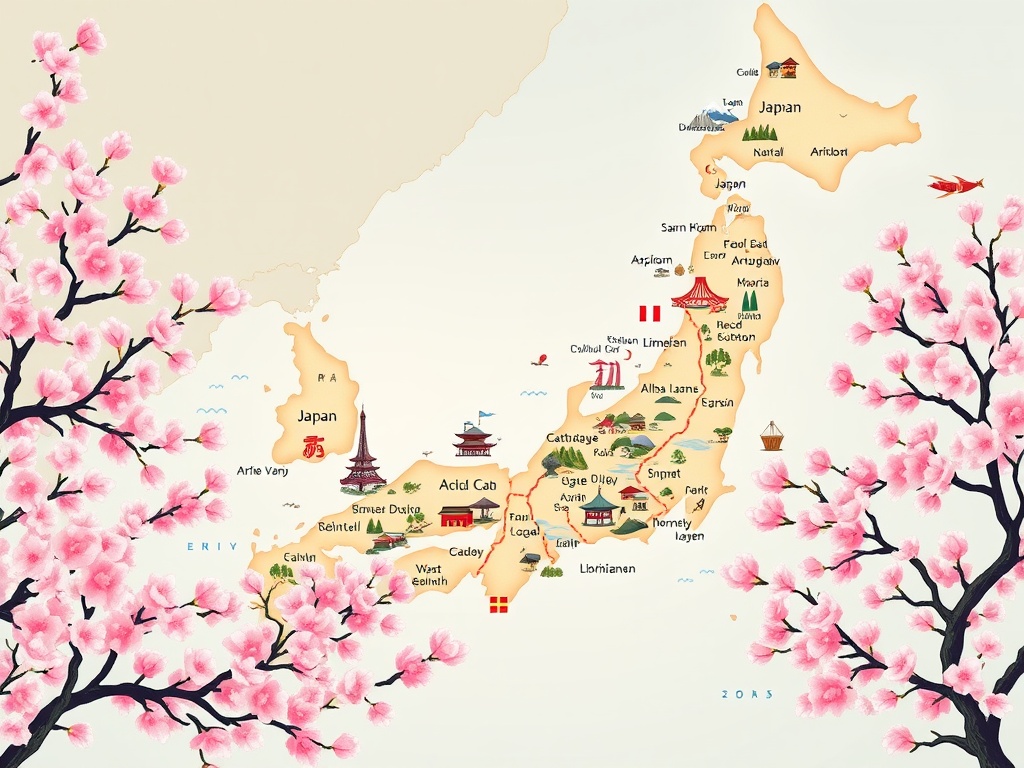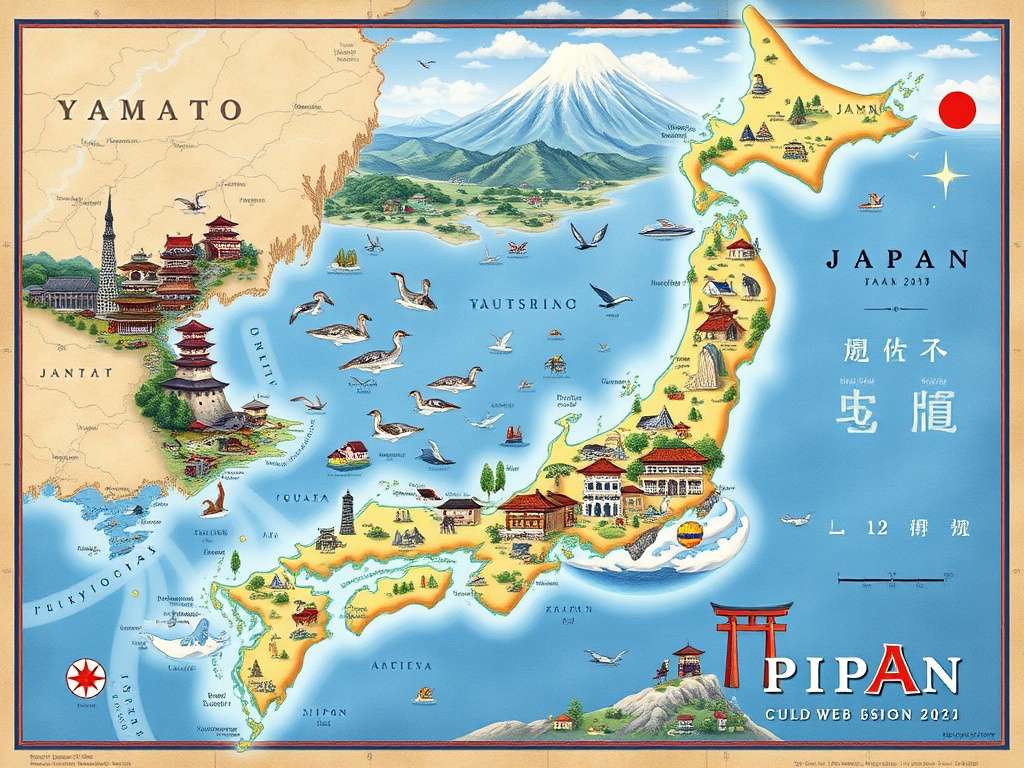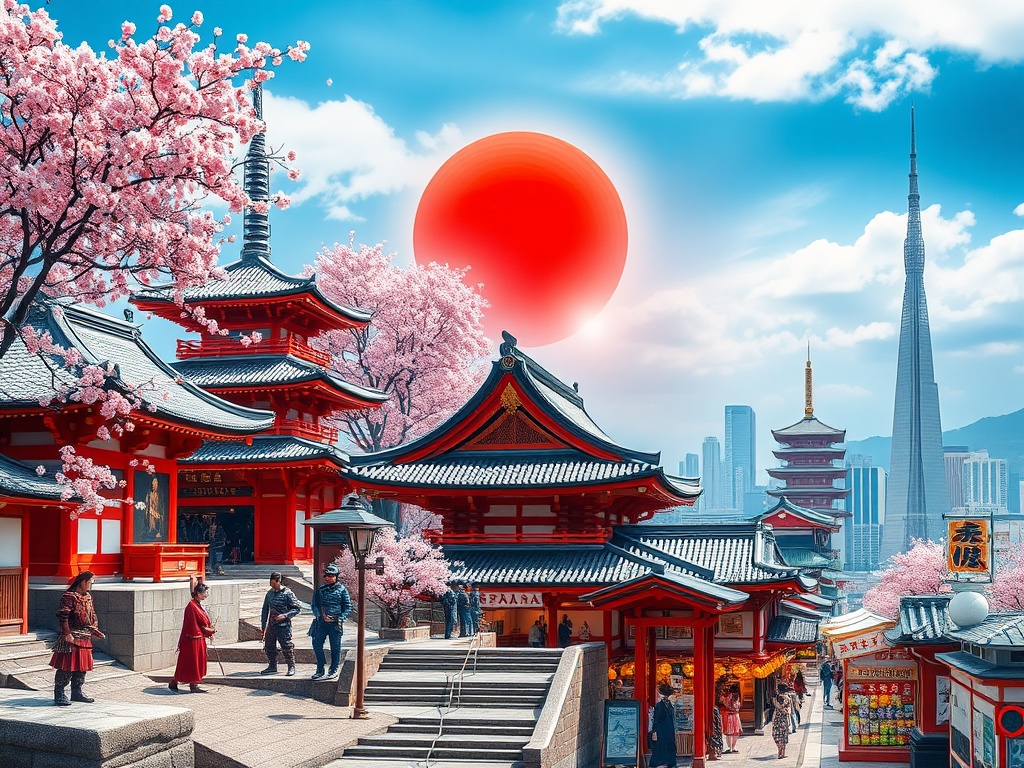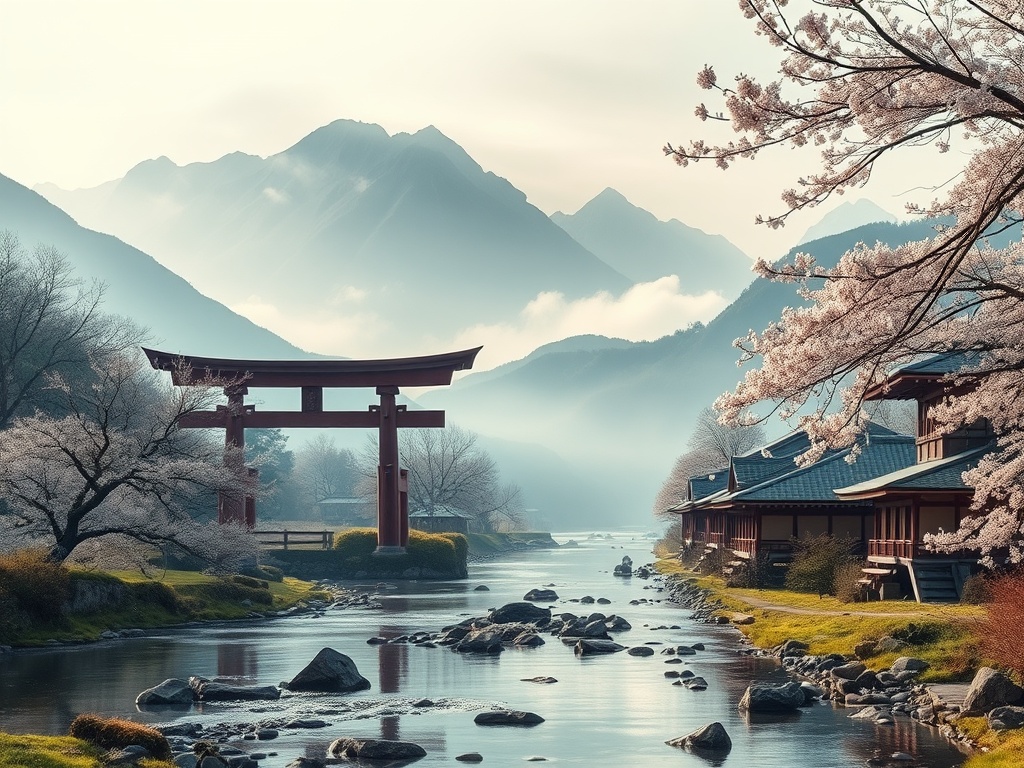From Yamato to Nippon: Tracing the Ancient Names of Japan
Win a Free Trip to Japan!
Experience cherry blossoms and ancient temples
Japan, a nation with a rich tapestry of history and culture, has been known by various names over the centuries. Each name reflects a different era, a unique cultural shift, or a significant historical event. For travel and tourism enthusiasts, understanding these names provides a deeper insight into Japan’s cultural evolution.
The earliest recorded name of Japan, Yamato, dates back to the 4th century. This name is deeply rooted in the period when the Yamato clan held power, and it signifies more than just a geographical region. The term ‘Yamato’ is often associated with early Japanese statehood and cultural identity. Travelers exploring the Asuka and Nara regions can still find historical sites and relics that echo the ancient Yamato spirit.
Noteworthy Historical Sites of the Yamato Era:
- Asuka Temple: Known as one of the earliest Buddhist temples in Japan.
- Yamato Sanzan: The three mountains of Yamato, offering picturesque landscapes and a peek into ancient Japan.
During the Han Dynasty in China, Japan was referred to as Wa, a name bestowed by the Chinese. This name was used in ancient Chinese texts and reflects the interactions and perceptions between these two ancient civilizations. For those interested in early Japan-China exchanges, the coastal areas of Kyushu present archaeological sites that narrate tales of early diplomacy and trade.
As Japan’s cultural and political landscape evolved, so did its name. By the 7th century, the name Nihon or Nippon began to appear in historical records. Translated as ‘origin of the sun’, it highlights Japan’s eastern position relative to the Asian continent. This is the name that resonates with the Japan of today, a nation known for its blend of ancient traditions and cutting-edge innovation. Visitors can witness this juxtaposition in cities like Tokyo and Kyoto, where ancient temples stand alongside modern skyscrapers.
Land of the Rising Sun: Evolution of Japan’s Identity
Japan’s journey through history is not just a tale of emperors and samurais, but also a fascinating narrative told through the evolution of its many names. Each name Japan has adopted over the centuries is a window into its evolving identity and cultural significance. This evolution from Yamato to Nippon and beyond is a captivating chronicle for travel and tourism enthusiasts keen on understanding Japan beyond its picturesque landscapes and bustling cities.
As Japan emerged into a cohesive nation-state, the names Nihon and Nippon became the symbols of its identity. These names, translating to ‘origin of the sun’, were not arbitrarily chosen but deeply rooted in geopolitical and cultural symbolism. Japan’s position to the east of the Asian continent led to this poetic descriptor, signifying the land where the sun rises. This name has become synonymous with Japan’s cultural renaissance and its emergence as a global power. The symbolism of the rising sun is vividly present in Japan’s national flag, a testament to its enduring identity. Travelers can experience this legacy in various cultural expressions, from traditional festivals to modern-day innovations.
Today, Japan’s identity as the ‘Land of the Rising Sun’ is reflected in both its historical consciousness and its contemporary outlook. Cities like Tokyo and Osaka are not only economic hubs but also cultural epicenters where the ancient and the modern coexist. The Sky Tree in Tokyo, for instance, offers panoramic views that capture the essence of a nation that honors its past while embracing the future. Visitors can explore ancient temples in Kyoto, where the past whispers through every corridor, or experience the rigorous discipline and grace of sumo wrestling, an ancient sport that continues to captivate audiences.
Unveiling Wa: Japan’s Ancestral Name and Its Mystique
Japan’s historical tapestry is embroidered with names that reveal its evolving identity and complex interrelations with neighboring cultures. Among these, the name Wa stands out, a term steeped in antiquity and enveloped in a certain mystique. For travel and tourism enthusiasts, delving into the era when Japan was known as Wa unveils a fascinating chapter of its history, offering a unique lens to explore Japan’s ancestral roots and its early interactions with the world.
The name Wa, used predominantly during the Han Dynasty in China, emerged from ancient Chinese texts. This era marks a period when Japan began making its presence known to its continental neighbors. The term ‘Wa’, while simple in its phonetic expression, was imbued with complex cultural connotations. It was not just a label but a narrative of how Japan was perceived by its powerful neighbor, China. For travelers, the legacy of Wa can be explored in the coastal regions of Kyushu, where early diplomacy and trade left their mark. These regions are treasure troves of archaeological finds, narrating tales of cultural exchange and maritime adventures that defined the era.
The Mystique of Wa: Cultural Exchanges and PerceptionsUnderstanding Wa involves exploring the dynamics of ancient Japanese and Chinese interactions. It was an era of burgeoning trade routes and cultural exchanges that laid the foundation for Japan’s later development. The name Wa, often seen in historical annals, symbolizes a time when Japan was crafting its identity on the international stage. The cultural exchanges during this period were extensive, influencing local customs, art, and governance. Visitors today can explore these influences in museums and historical sites that host artifacts and exhibits from this intriguing epoch.
Legacy of Wa in Modern JapanThe influence of the Wa era is still palpable in modern Japan. The ethos of harmonious living, which the term ‘Wa’ embodies, continues to resonate in Japanese society today. Whether it’s in the harmonious balance of traditional and modern architecture or the cultural emphasis on community and cooperation, the spirit of Wa persists. This enduring legacy can be experienced in the serene landscapes and cultural practices that dot the nation, inviting travelers to witness how ancient traditions continue to shape modern Japan.
Nihon or Nippon? The Modern Debate Over Japan’s Name
As Japan continues to captivate the world with its harmonious blend of ancient traditions and cutting-edge advancements, the question of its name remains a topic of interest and debate. The dual names ‘Nihon’ and ‘Nippon’ both translate to the ‘origin of the sun’, yet they offer distinct cultural and historical nuances that intrigue scholars, linguists, and travelers alike. This debate is more than a linguistic preference; it is a reflection of Japan’s dynamic identity and its ongoing dialogue with its past and future.
The interchangeability of ‘Nihon’ and ‘Nippon’ is unique to Japan. While both are used to refer to the country in the Japanese language, their usage often varies based on context and formality. ‘Nihon’ is commonly used in everyday conversation and informal settings, whereas ‘Nippon’ is favored in formal contexts and official titles. This duality adds a layer of complexity to Japan’s identity, inviting travelers to explore the subtleties of its cultural expressions and linguistic traditions.
For those visiting Japan, understanding when to use ‘Nihon’ versus ‘Nippon’ can enrich the travel experience. Here are some contexts where each name might be preferred:
- Nihon: Often used in casual conversation, and found in many popular cultural references and media.
- Nippon: Utilized in formal situations, such as official documents, international sports, and nationalistic expressions.
Travelers can immerse themselves in this intriguing aspect of Japan by engaging with locals and participating in cultural events where the names might be used interchangeably. Visiting museums and exhibitions that delve into Japan’s linguistic history can also offer insights into why this dual naming persists. From the bustling streets of Tokyo to the serene temples of Kyoto, the echoes of ‘Nihon’ and ‘Nippon’ provide a fascinating backdrop to any journey across this enchanting nation.
The Chronicles of Jipangu: Marco Polo’s Enchanted Isles
In the annals of history, few names have sparked as much intrigue and mystique as Jipangu, the term used by the Venetian explorer Marco Polo to describe the distant and enigmatic islands of Japan. This name, steeped in the lore of medieval exploration, paints a picture of a land shimmering with riches and cultural splendor. For travel and tourism enthusiasts, tracing the footsteps of Marco Polo through Japan’s historical landscapes offers a captivating glimpse into the narratives that once enchanted the Western world.
Marco Polo’s tales of Jipangu were filled with wonder, describing an island nation abundant in gold and pearls, captivating the imaginations of those who read his accounts. Although his descriptions were somewhat embellished, they sparked a fervent interest in Japan and marked it as a land of mystical allure. The allure of Jipangu can still be felt today in the cultural richness and historical depth that define modern Japan. Travelers can explore the regions mentioned in Polo’s accounts, such as the port cities that were once gateways for explorers and traders alike.
Embark on a journey to experience the legacy of Jipangu through a selection of sites that echo Marco Polo’s vision of this fabled land:
- Hiraizumi: Once a flourishing city during the Heian period, it reflects the grandeur that Marco Polo might have envisioned.
- Sado Island: Known for its gold mines, it resonates with Marco Polo’s tales of wealth and prosperity.
- Kyoto: A historical gem that offers a glimpse into the cultural wealth Polo described, with its temples and traditional architecture.
Today, travelers can experience the spirit of Jipangu not just through its historic sites but also by engaging with Japan’s vibrant culture, which continues to blend ancient traditions with modern innovations. From the bustling markets of Tokyo, where the past meets the present, to the serene landscapes that have changed little since Polo’s time, Japan offers a tapestry of experiences that continue to captivate adventurers and historians alike.
Kuni no Miyatsuko: Exploring Japan’s Regional Titles
Japan’s history is not just a story of a nation but a mosaic of regional identities and titles that reflect its diverse and rich cultural heritage. The concept of Kuni no Miyatsuko, or regional titles, opens a fascinating window into the administrative and cultural landscape of ancient Japan. For travel and tourism enthusiasts, exploring these regional titles offers a unique perspective on how local governance and cultural identities were shaped in ancient Japan and how they continue to influence modern society.
The term Kuni no Miyatsuko refers to the provincial governors appointed by the Yamato court during the Kofun to Nara periods. These regional leaders were responsible for managing the provinces, collecting taxes, and maintaining order, serving as the bridge between the central authority and the local populace. For travelers, understanding the legacy of these figures provides insight into the historical governance structures that were instrumental in shaping Japan’s regional cultures. Visitors can explore regions where these leaders once ruled, discovering historical sites that echo the administrative prowess and cultural influence of the Kuni no Miyatsuko.
Japan’s provinces, each with unique administrative titles, offer a tapestry of experiences that reflect their historical significance. Travelers can embark on a journey to uncover the remnants of these ancient titles through various historical sites and cultural landmarks. Here are some must-visit provinces known for their historical significance and regional titles:
- Yamashiro Province: Home to Kyoto, this province is steeped in rich history and cultural landmarks.
- Izumo Province: Known for its ancient shrine, Izumo Taisha, a testament to its historical religious significance.
- Owari Province: Modern-day Aichi Prefecture, offering a blend of historical sites and modern attractions.
Even today, the influence of Kuni no Miyatsuko can be seen in Japan’s cultural festivals and regional pride. Many traditional celebrations and rituals trace their origins back to the days when these regional titles were prominent. Travelers can immerse themselves in this cultural heritage by participating in local festivals and visiting museums that showcase artifacts and exhibits related to Japan’s regional governance. Such experiences allow visitors to appreciate the enduring legacy of these ancient titles in shaping Japan’s provincial identities.
Japan’s Names Through Time: A Journey Across Dynasties
The historical names of Japan offer a fascinating glimpse into the nation’s past, reflecting the shifts in power, culture, and international relations over the centuries. As travelers delve into Japan’s history, they encounter a rich tapestry of names that each tell a unique story, providing a portal to the eras in which they were used. From the majestic courts of ancient dynasties to the evolving identity of a modern nation, these names are more than mere designations—they are narratives of a nation’s journey through time.
During the Yamato Period, Japan was unified under the Yamato clan, marking the beginning of a centralized state. The name Yamato itself became synonymous with the early formation of Japanese culture and governance. This era is significant for its consolidation of power and the establishment of early political structures. Travelers exploring regions like Nara can witness relics and monuments that resonate with the spirit of Yamato, such as the famous Asuka Temple, which stands as a testament to the era’s religious and cultural advancements.
As Japan transitioned from the Heian to the Edo period, the names and cultural identity continued to evolve. The Heian period is often remembered for its refinement and the flourishing of art and literature, with Kyoto serving as its cultural heart. During this time, Japan was often referred to as Nihon or Nippon, reflecting its growing self-awareness and cultural renaissance. The Edo period, known for its peace and stability under the Tokugawa shogunate, saw a further solidification of national identity. Travelers can explore this era through the preserved streets of Kyoto and Edo (modern-day Tokyo), where the past whispers through every alley and courtyard.
In the modern era, Japan’s names have come to symbolize its position on the global stage. As Nihon or Nippon, the country is recognized worldwide as the Land of the Rising Sun. This name encapsulates Japan’s enduring spirit and its ability to blend tradition with modernity. Cities like Tokyo and Osaka reflect this duality, where ancient traditions meet cutting-edge innovation, offering travelers a unique experience of Japan’s dynamic identity. The modern usage of these names in international forums and cultural exchanges underscores Japan’s ongoing dialogue with the rest of the world, inviting travelers to explore a nation that honors its past while embracing the future.



